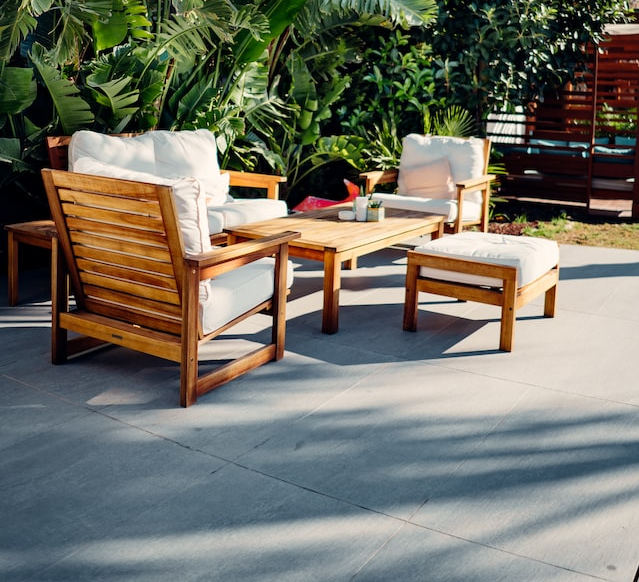Bluestone is quite versatile and makes the landscape appear elegant. You can find it in walkways, patios, and steps. But the problem with using this material in a patio is debris and stains that seem difficult to remove. So, you need to know how to clean and maintain a bluestone patio.
Steps to Clean a Bluestone Patio
Here are the steps you’d need to follow to have a clean, dust-free bluestone patio:
- Wipe the area with a soft towel to get rid of dust that may be on the surface.
- Mix half a cup of dishwashing liquid in a bucket of water.
- Dip a brush into the bucket to get it wet, then use it to scrub the tiles gently.
- Keep scrubbing until you’ve covered the entire area.
- Discard the mixture, which would probably be dirty by now, then fill the bucket with clean water.
- Rinse the brush, then dip it into the bucket of clean water to wipe the soap off the tile.
- Attach a small sprayer nozzle to one end of a hose and run some water on the tiles.
- Continue spraying water until the patio is clean.
- Allow it to air dry.
If you don’t have a small nozzle, you can use your power washer. However, it should be done with caution because high-pressure water can damage bluestone.
Also, if the tiles still look dirty, you can spot-clean them with a mixture of lemon juice and water. Allow the mixture to settle into the tiles, then scrub in a circular motion. Ensure to rinse with enough water.

Using a Stone Cleaner
Alternatively, you can use a stone cleaner to clean bluestone. Here’s how to use it:
- Get a stone cleaner that’s suitable for bluestone. If you’re not sure about the one to buy, the storekeeper can guide you.
- Mix the cleaner in a bucket of water, following the manufacturer’s instructions.
- Apply the mixture on the tiles using a soft brush and allow it to sit for about 10 to 15 minutes.
- Rinse the tiles with clean water.
To test whether your stone cleaner is suitable for bluestone, apply the mixture on a small portion of the tiles using a soft brush and leave it for about five minutes. If it dries and your tiles lose some color, then the cleaner is too strong and unsuitable for your bluestone.
How to Remove Biological and Organic Stains from Bluestone
Biological stains can come from mildew, algae, or moss, while organic stains include blood, food, coffee, wine, and juice. You can use an oxidizer like bleach, hydrogen peroxide, or ammonia to get rid of them, but make sure to wear protective clothing.
If you’re using bleach, avoid cleaning your patio under the direct sun because it’ll evaporate before you start cleaning. You can follow these steps to remove organic stains from your bluestone patio:
- Mix half a cup of an oxidizer in a gallon of warm water.
- Use a mop to apply the mixture to the stained portions.
- Allow it to sit for five to ten minutes.
- Scrub gently with a brush.
- Rinse thoroughly with clean water.
For the best results, you should add a few drops of ammonia to diluted hydrogen peroxide and apply them on stubborn stains. Leave the mixture for about five to ten minutes, then rinse with water.
If you don’t have hydrogen peroxide, don’t attempt mixing bleach with ammonia. They both contain ingredients that can form toxic gases known as chloramines, which can be toxic.
Tips for Maintaining Your Bluestone Patio
Bluestone is easy to maintain. The following tips are recommended for proper bluestone maintenance:
- Sweep debris away from the tiles every day.
- Use a soft towel or brush and warm water to clean spills as soon as they occur.
- Remove oil stains with soap or ammonia and water.
If you notice white spots on the tiles, it’s a sign of efflorescence, which means that minerals like magnesium and calcium have settled on them. These could come from cleaning agents and water. However, you can use baking soda and vinegar or a bluestone alkaline cleanser to remove them. Over time, your bluestone patio may lose its protective layer. To ensure that it’s protected from stains and mineral deposits, renew its sealing.
Conclusion
Bluestone requires regular sweeping and cleaning with soap and water. It may also require the use of stain removers like hydrogen peroxide, ammonia, and lemon juice. However, the key to maintaining its appearance is to wipe off spills quickly.
But if deposits accumulate on your bluestone due to the elements and regular cleaning, baking soda and vinegar can restore its looks. And don’t forget to finish it with another sealing.

